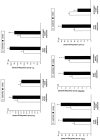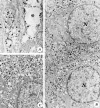Brief and repeated noise exposure produces different morphological and biochemical effects in noradrenaline and adrenaline cells of adrenal medulla
- PMID: 11895114
- PMCID: PMC1570642
- DOI: 10.1046/j.0021-8782.2001.00014.x
Brief and repeated noise exposure produces different morphological and biochemical effects in noradrenaline and adrenaline cells of adrenal medulla
Abstract
Exposure to stressful stimuli is known to activate the peripheral sympathetic nervous system and the adrenal gland. In this study, we evaluated the effects of single or repeated bouts of exposure to a readily measurable stressful stimulus (loud noise) on the catecholamine content and ultrastructure of the rat adrenal medulla. In particular, we measured tissue levels of dopamine, noradrenaline, adrenaline and metabolites. In parallel studies, we evaluated the fine ultrastructure of catecholamine cells, including a detailed study of catecholamine granules and a morphometric analysis of adrenaline and noradrenaline medullary cells. Animals were exposed either to a single (6 h) session of loud (100 dBA) noise, or to this noise stimulus repeated every day for 21 consecutive days. There was a marked correlation between biochemical indexes of catecholamine activity and the ultrastructural morphometry of specific catecholamine granules. Exposure to loud noise for 6 h induced a parallel increase in dopamine, noradrenaline, adrenaline and their metabolites, a polarization and an increased numerical density of noradrenaline and adrenaline granules in the cells. After repeated noise exposure, noradrenaline levels were significantly higher than in controls, and adrenaline decreased significantly. In addition, adrenaline cells also exhibited ultrastructural alterations consisting of wide homogeneous cytoplasmic areas and large, pale vesicles.
Figures



Similar articles
-
A quantitative analysis of rat adrenal chromaffin tissue: morphometric analysis at tissue and cellular level correlated with catecholamine content.Neuroscience. 1987 Mar;20(3):895-904. doi: 10.1016/0306-4522(87)90250-8. Neuroscience. 1987. PMID: 3601067
-
Effects of hypophysectomy and metyrapone on the catecholamine content and volumes of adrenaline- and noradrenaline-storing cells in the rat adrenal medulla.J Endocrinol. 1984 Jun;101(3):345-52. doi: 10.1677/joe.0.1010345. J Endocrinol. 1984. PMID: 6726110
-
Combined stereological and biochemical analysis of storage and release of catecholamines in the adrenal medulla of the rat.J Neurochem. 1984 Feb;42(2):434-7. doi: 10.1111/j.1471-4159.1984.tb02696.x. J Neurochem. 1984. PMID: 6363625
-
Morphological aspects of chromaffin tissue: the differential fixation of adrenaline and noradrenaline.J Anat. 1993 Oct;183 ( Pt 2)(Pt 2):223-35. J Anat. 1993. PMID: 8300413 Free PMC article. Review.
-
Noradrenaline: fate and control of its biosynthesis.Science. 1971 Aug 13;173(3997):598-606. doi: 10.1126/science.173.3997.598. Science. 1971. PMID: 4397955 Review. No abstract available.
Cited by
-
The Role of Sound in Livestock Farming-Selected Aspects.Animals (Basel). 2023 Jul 14;13(14):2307. doi: 10.3390/ani13142307. Animals (Basel). 2023. PMID: 37508083 Free PMC article. Review.
-
Geo-Demographic and Socioeconomic Determinants of Diagnosed Hypertension among Urban Dwellers in Ibadan, Nigeria: A Community-based Study.Res Sq [Preprint]. 2023 Dec 20:rs.3.rs-3692586. doi: 10.21203/rs.3.rs-3692586/v1. Res Sq. 2023. Update in: J Health Popul Nutr. 2025 Feb 28;44(1):55. doi: 10.1186/s41043-024-00704-2. PMID: 38196605 Free PMC article. Updated. Preprint.
-
Relationship between occupational noise exposure and the risk factors of cardiovascular disease in China: A meta-analysis.Medicine (Baltimore). 2018 Jul;97(30):e11720. doi: 10.1097/MD.0000000000011720. Medicine (Baltimore). 2018. PMID: 30045338 Free PMC article. Review.
-
Effects of patient-level noise abatement orders on sound levels experienced by critically ill subarachnoid hemorrhage patients: an observational study.Hosp Pract (1995). 2020 Dec;48(5):258-265. doi: 10.1080/21548331.2020.1801008. Epub 2020 Aug 22. Hosp Pract (1995). 2020. PMID: 32729755 Free PMC article.
-
The Impact of Acute Loud Noise on the Behavior of Laboratory Birds.Front Vet Sci. 2021 Jan 6;7:607632. doi: 10.3389/fvets.2020.607632. eCollection 2020. Front Vet Sci. 2021. PMID: 33490135 Free PMC article.
References
-
- Alario P, Gamallo A, Beato MJ, Trancho G. Body weight gain, food intake and adrenal development in chronic noise stressed rats. Physiol. Behav. 1987;40:29–30. - PubMed
-
- Armario A, Castellanos JM, Balash J. Adaptation of anterior pituitary hormones to chronic noise stress in rats. Behav. Neural. Biol. 1984;41:71–76. - PubMed
-
- Axelrod J, Reisine TD. Stress hormones: their interaction and regulation. Science. 1984;224:452–459. - PubMed
-
- Baron S, Brush FR. Effects of acute and chronic restraint and estrus cycle on pituitary-adrenocortical function in the rat. Hormones Behav. 1979;12:218–224. - PubMed
-
- Basset JR, Cairncross LD, King MG. Parameters of novelty, shock predictability and response contingenity in corticosterone release in the rat. Physiol. Behav. 1973;37:559–561. - PubMed
Publication types
MeSH terms
Substances
LinkOut - more resources
Full Text Sources
Medical

